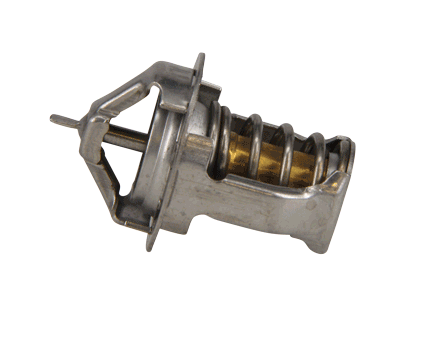This small thing at fault can vandalize your Engine, if not taken care of.
For an invention to be time-honoured, there is a constant need for innovation to make it sustain, and thrive to suit the dynamic changes that the world undergoes with time. Automotive industry has seen a tremendous growth in innovation in the past decade, which made vehicles more environmental friendly, attractive, and utilitarian. Today, we would be discussing about a vital component, which is smaller in size but equivalently bigger in terms of role it performs.
Thermostat

Thermostat is a device which is responsible for maintaining a constant temperature within a system. The optimum temperature at which an engine performs effectively, ranges from 90°C to 110°C, the thermostat aids in keeping the engine temperature, hanging around the optimum range of temperature.
A thermostat does its job by acting as a valve, which sits in between the engine and the radiator - a unit for the dissipation of heat from the engine to maintain a constant temperature band.
If you are observing the following symptoms, then your thermostat might be at fault.
- Temperature gauge redlines after few kilometers of running the vehicle.
- Leaking of the neon green liquid (coolant) under the engine bay.
- Bad performing air conditioner and heater.
- Increased cabin temperature.
Consequences of diverting away from the optimum temperature band
In order to maintain a constant temperature band of the engine, a coolant is circulated throughout the engine which absorbs excessive heat of the engine, and dissipates the heat out of the engine by returning to the radiator which cools down the coolant, and the coolant after losing its temperature, becomes ready for its next round trip.
The circulation of coolant takes place only when the coolant reaches its higher temperature, in lower temperatures, coolant is immobile.
This continuous cycle of circulation of coolant between the engine and the radiator keeps the engine maintain its optimum temperature.
What if, this cycle was uncontrolled?
The coolant would circulate through the engine bringing its excessive heat, and reach back to the radiator, where it would cool itself, and would take another round trip through the engine, this uncontrolled and recurring cycle would lead to over-dissipation of heat, and there will be an instance, where the engine temperature will begin to fall below its optimum temperature, thus making it needy for more fuel to burn and warm up itself, in turn, leading to poor warm-up and increased emissions from the engine. Nowadays, thermostat is a must for every engine, where fuel supply is electronically controlled via computer, in essence, the ECU. When ECU would detect the fall in temperature of the engine, it would increase the supply of fuel into the engine to keep it maintain the optimum temperature, thus reducing the fuel efficiency of the engine.
How thermostat does its job?
As discussed earlier, thermostat acts as a valve that sits between the engine and the radiator, the main role of the thermostat is to regulate the cycle of circulation of the coolant. Thermostat keeps the valve closed at cold engine temperatures, which stops the coolant from circulating. This helps when engine is cold below its working temperature, it keeps the coolant locked into the engine block which helps to make the engine reach its working temperature a bit quicker. As soon as the temperature reaches its optimum level, the thermostat valve opens up to allow the hot coolant to flow towards radiator.
To the contrary, when engine temperatures are higher beyond the optimum temperatures, it opens the valve, and lets the hot coolant return to the radiator unit after having absorbed the excess heat from the engine, where the coolant gets cooled by the incoming air that passes continuously through the radiator, when vehicle is at motion.
This round trip of coolant is administered by a Thermostat.
Let's dip into the complex working of the device. Thermostat has a small cylinder, which is filled with wax, and a valve connected with a rod, which rests onto the wax in the cylinder. This cylinder is placed towards engine side from where the hot coolant comes in contact with the cylinder. The cylinder on coming in contact with the hot coolant gets heated up, which in turn melts the wax within the cylinder. The molten wax expands and pushes the rod connected with the valve, upwards, which opens up the valve and makes a space for the hot coolant to pass through the valve.
Based on the Principle of Thermal expansion, this device serves in maintaining the efficiency of the engine, longevity of the engine and its components.


Thanks for sharing
ReplyDelete